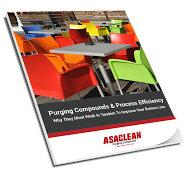 High-output thermoplastics injection molding creates carbon contamination buildup over time, resulting in high scrap rates and excessive downtime during resin transitions. These plastics processing issues hinder production runs while syphoning money from your profit pool.
High-output thermoplastics injection molding creates carbon contamination buildup over time, resulting in high scrap rates and excessive downtime during resin transitions. These plastics processing issues hinder production runs while syphoning money from your profit pool.
The following purging compound tips are designed to help you remove carbon contamination for quick resin transitions:
- Use A Commercial Purging Compound (CPC) To Facilitate Color Changes
Once contamination begins, some level of intervention is necessary. However, resins, regrinds and detergents are not made for cleaning plastic processing machines, and do not efficiently facilitate color changes.
There are two ways to remove carbon contamination. There is the manual method of pulling the screw to clean it. When carbon contamination is at its worst, color changes become so challenging you may have to pull the screw for each changeover. The cumulative outcome is too much wasted production time.
The most effective method is using a purging compound. In most cases, resin transitions are dramatically shortened with the use of a purging compound by eliminating residue and contamination. By reducing changeover times and wasted materials, you gain a competitive advantage for your business.
However, using purging compounds requires knowing how to use the product properly to maximize its cleaning power. - Ensure You Are Using The Right Purging Compound Product Grade
The right CPC manufacturer offers a variety of grades to purge specific types of resins. There must be compatibility between the base resin used in the purging compound and the resins purged.
Keep in mind the melt index (MI) of your thermoplastic materials, as this also has an effect on what grade of purging compound you choose. Purging compound grades are designed to work with the processing temperature being used. - Clean The Nozzle And Check Ring
Color hang-up often occurs in tight areas like the nozzle and check ring. After completing general purging procedures for cleaning the screw and barrel, it’s recommended to then charge the machine with a small quantity of purging compound (less than half-barrel capacity) and perform short, high-velocity injection shots.
Mixing nozzles, in particular, are notorious for having color and degraded material hang-up (due to design and greater shearing). So, the action of short, high-velocity shots blasts purging compound into tight areas and dead spots the material would not reach otherwise. - Purge Hot Runners With An Appropriate Purging Compound
Some plastics processors are unwilling to put anything other than resins through their hot runners. However, most CPC manufacturers offer grades designed specifically for hot runners.
If you’re using hot runners, check with your purging compound supplier for the right grade to use, as not all grades are recommended for hot runner cleaning. Also, ask your supplier about proper purging procedures for hot runner cleaning, as the method is typically different from purging other machine parts. - Address Carbon Contamination Immediately
Once you start seeing occasional black specks in your purge pile, carbon contamination has already progressed in the barrel. Don’t wait. Use a strong purging compound (such as a glass-filled grade) to clean the machine before starting the next production run.
Excessive downtime negatively impacts your ability to hit or exceed business projections; wasted product left in the purge pile equals money you could’ve put towards future growth goals to stay ahead of your competitors.
With the right purging compound and procedures, you effectively remove carbon contamination so your production runs are on track.
Ready to reduce carbon contamination for faster resin transitions? Discover why purging compounds and process efficiency must work in tandem.







Comments